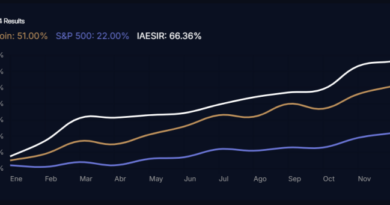Argentina’s Stablecoin Boom After Government Suggestion of Abandoning Currency Controls
Key Takeaways:
- Argentina’s stablecoin turnover rose by as much as 250% overnight.
- Shift to abandon currency controls fueled increasing demand for crypto hedging.
- USDT and USDC dominated the boom, especially from retail consumers.
- The shift indicates ongoing lack of faith in the peso and the trend towards financial alternatives.
Currency Controls in Argentina: An Age-Old Obstacle
Argentina has long been renowned for centuries of convoluted and largely restrictive currency policy. Capital controls, namely restrictions on buying foreign currencies like the U.S. dollar, have been in place to manage inflation as well as protect dwindling foreign reserves. This has led many Argentinians to seek alternatives elsewhere, including the black market, cryptocurrencies, and more recently stablecoins, to preserve their value.
Against this backdrop, the latest announcement from the Argentine government of giving up on currency controls was a mammoth policy flip. While specifics are yet to be implemented, even the promise of imminent change generated instant reactions from both traditional markets and the crypto asset ecosystem.

A 250% Rise in Stablecoin Demand
Within moments of the release, local exchanges indicated a steep surge in stablecoin trading. Stablecoin trading volumes like Tether (USDT) and USD Coin (USDC) increased by 150% to 250% in less than 24 hours, several Argentine exchanges said.
This surge was not limited to institutional or high-net-worth customers. Most of the transactions were indeed retail users, a sign of grass-roots level demand for dollar-pegged digital currencies. Stablecoins have often acted as a financial lifeboat in inflation-stricken economies and monetary upheaval, and Argentina is a prime example.
Stablecoins as a Hedging Strategy
In Argentina, where dollar savings have been the popular choice for a long time, stablecoins are now the digital version of that behavior.
Even during the previous years under strict controls, most Argentinians evaded capital controls by using peer markets and crypto exchanges to buy dollar-denominated assets. This practice is on the rise with the policy shift recently:
- Platforms like Lemon Cash and Ripio experienced record traffic.
- Traders quickly converted pesos into stablecoins in an attempt to escape volatility.
- Peer-to-peer exchanges experienced strong buy-side demand for USDT.
Political and Economic Signals
The new policy direction is overseen by President Javier Milei, a vociferous deregulationist and Bitcoin advocate. His administration signaled a more embracing attitude toward free markets and fintech innovation. While the entire road map to eliminating currency controls is still under construction, the market reaction speaks volumes about how much the populace craves monetary alternatives.
The Argentine Central Bank has not released follow-up details yet, but all expect crypto markets to remain operating until there is absolute clarity. Until that time, stablecoins will most likely continue to function as hedge and bridge — from the fiat world into digital alternatives.
Stablecoin Volatility and Premiums
Interestingly, the boom also produced temporary premiums on stablecoin prices in Argentina. On some platforms, USDT was trading at prices slightly above its dollar peg, reflecting desperate demand and limited near-term supply. This kind of behavior is not new in Argentine crypto markets — in the past when economic stress has emerged, local prices for crypto assets have had a tendency to decouple from global averages.
It’s also interesting to note that while most of the volume was done by centralized exchanges, decentralized platforms also saw spikes in usage. Swaps-supported wallets directly via smart contracts (like MetaMask with swap functionality built-in) became a user favorite among those worried about delays or limitations.
Wider LATAM Implications
Argentina’s experience may have reverberations across the broader Latin American continent, as Venezuela and Colombia, which also are subject to high inflation or currency volatility, previously trended likewise. When trust in fiat disappears, digital currencies — and specifically stablecoins — follow.
What is unique about Argentina’s circumstances currently is the availability of regulatory support. Rather than clamping down on crypto, the new government seems open to embracing it as part of the economic landscape.
More News: President Milei Faces Investigation Over Crypto Scandal in Argentina
The post Argentina’s Stablecoin Boom After Government Suggestion of Abandoning Currency Controls appeared first on CryptoNinjas.
CryptoNinjas





















